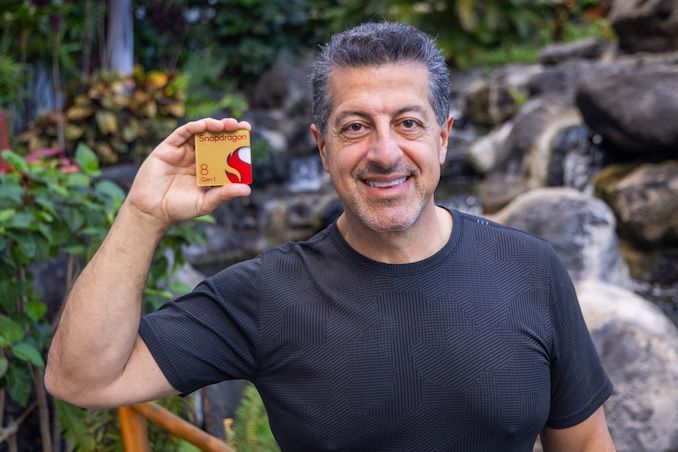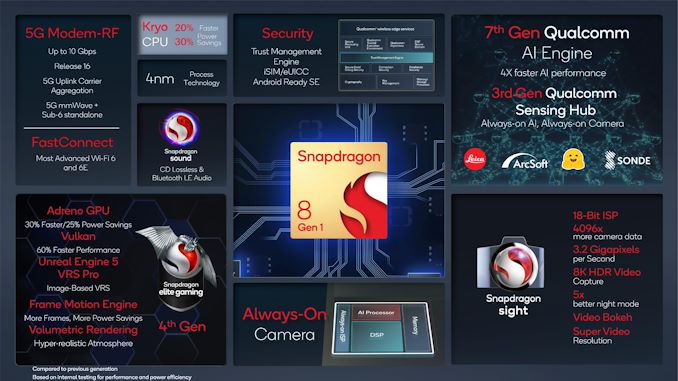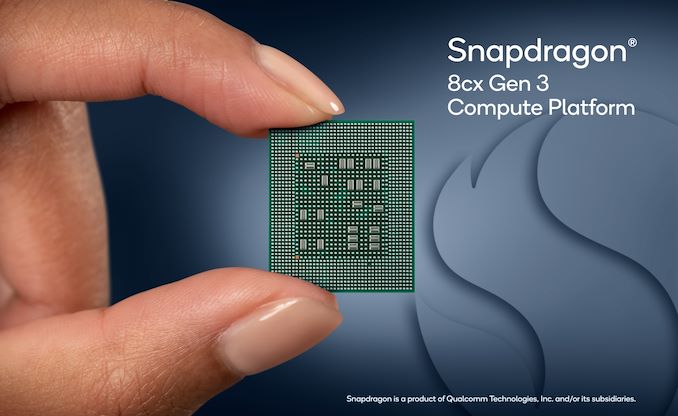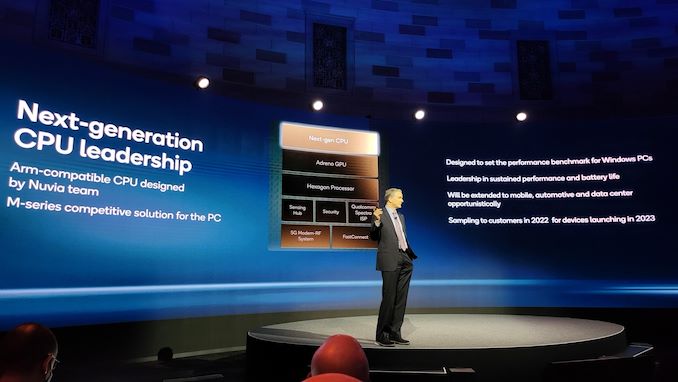Interview with Alex Katouzian, Qualcomm SVP: Talking Snapdragon, Microsoft, Nuvia, and Discrete Graphics
by Dr. Ian Cutress on January 31, 2022 10:00 AM EST- Posted in
- SoCs
- Snapdragon
- Qualcomm
- Smartphones
- 5G
- ACPC
- Interviews

Two driving forces are driving the current technology market: insatiable demand for hardware, and the supply chain shortages making it difficult to produce enough in quantity to fulfil every order. Even with these two forces in action, companies have to push and develop next generation technologies, as no competitor wants to sit on their laurels. That includes Qualcomm, and as part of the Tech Summit in late 2021, I sat down with Alex Katouzian, Qualcomm’s GM of Mobile, Compute, and Infrastructure to talk about the issues faced in 2021, the outlook for 2022, where the relationships lie, and where innovation is headed when it comes to smartphone and PC.
We’ve interviewed Alex a couple of times here at AnandTech, and while he has been well trained in dealing with the likes of our pointed questions, we can tell he’s being open and honest, telling us as much as he can (and sometimes a little bit extra). Alex has been at Qualcomm for 20 years, working his way up through wireless mobile technologies, product management, and taking over the MCI business unit in 2017. Prior to that Alex was engineering multimedia and wireless chipsets, showcasing that his whole career has been about putting next-generation connectivity into as many gadgets as possible.
 Alex Katouzian SVP and GM Mobile |
 Ian Cutress AnandTech |
Ian Cutress: Here at Qualcomm’s Tech Summit, you are announcing the new Snapdragon 8 Gen 1, with new marketing, and it’s a new chip on Arm v9. I kind of want to step back and look at the year as a whole – Qualcomm launched the Snapdragon 888, and that's been in a lot of flagships, accompanied by a lot of them with Qualcomm 5G RF solutions. I know you're an employee, and I know you're probably biased, but objectively what grade would you give Qualcomm for the year?
Alex Katouzian: Well our Snapdragon 888 is top in premium tier solutions. When you look at the capabilities that were available to our customers and ecosystem through the technologies we provided, we topped the chart in terms of graphics capability, overall performance, AI capability, and camera performance - there are multiple phones on the 888 that are topping out on DXOmark. I would say our Elite Gaming capability was very good, we’ve done that in cooperation with the developers and game engine developers. All of them were very cottoned on. So overall, I would say a pretty high grade on the overall performance of a premium tier phone.
IC: Would you say you've had any pinch points this year, that get solved next year?
AK: Obviously the pandemic brought on some supply chain issues, and the severity of them fluctuated throughout from the end of 2020 through into 2021. But by being a fabless company, it allowed us the freedom to be able to move from fab to fab, not only on the latest digital parts of technology, but also on the old analog technology we've had the ability to move from fab to fab as well. We alleviated a lot of the supply issues based on the ability to have engineering resources available to move parts and make room for shipments to happen. Even though we still went through some supply crunches, and we probably will go through some supply crunches in 2022, we alleviated a lot of that, and we are able to get out our products.
IC: Does moving from fab to fab like that disrupt the unique relationships with each foundry?
AK: The relationship between a fabless semiconductor company like us and the foundry has to be very tight. But these were unprecedented times, and the ripple effects were great because the supply chain usually takes about 18 months to 2 years to come to fruition. When we had that shutdown period of say, 9-10 months, every facility in the supply chain was shutting down. They had to restart that, to recalibrate equipment, to hire staff, and any expansion plans were on hold. Then the surge in demand for consumer electronic equipment was so high that it takes time for it to catch up. Given these ‘unprecedented times’, I don't think that a foundry is going to blame a company like us to try to diversify in such a way that it allows us to ship products. If you look further down the supply chain, we are suppliers to our customers, and they're gonna have to diversify in their supply as well, and someone had to make that choice.
IC: Aha, so goes both ways, both up your chain and down it.
AK: Exactly!
IC: So when I came to my first Qualcomm Tech Summit, the venue had specialist equipment installed for 5G because we were still very early, very nascent in 5G. The rollout at the time was more focused on industrial applications, but a good amount of the talk was on mmWave versus Sub-6. Where the US is focusing on mmWave, the rest of the world was focused on Sub-6. If feels kind of odd, but we're kind of still having those discussions! What has changed from Qualcomm’s point of view in those discussions?
AK: I think more and more, the carriers are realizing that ‘a layered cake effect’ of their network, spreading out, becomes a more necessary thing to do in crowded environments or congested areas. mmWave roll-out, even though sometimes it a little bit more difficult because the amount of base station towers, you have to have a lot more of them, even though they are a little bit more difficult, carriers are realizing that it actually is much better to have mmWave in congested areas. Then, as you go further out to more suburban areas, that Sub-6 can cover and even more, maybe possibly even falling back to LTE.
But that realization, and the deployment of the equipment - remember, we're at the end of the second year of the commercial release of 5G, and for every G, the transition takes between 10 to 12 years. So the rollout of mmWave is going to start to happen more. I think more countries are going to start to deploy: we have deployment in Japan; Korea is slowly starting to come up; China's starting to think about the fact there's lots of bandwidth available there for them. Then the sectors that mmWave can get applied to are so much wider than what we had before, in different sectors of say economy, manufacturing, retail - and then you have other means of deploying mmWave to private networks via small cell. Those are all helping. I think when you look at industrial, when you look at manufacturing, when you look at automotive, there’s a lot of room to grow for mmWave, and that expansion is going to be from the ecosystem.
IC: For this event, we're learning a lot about Snapdragon 8 Gen 1. As you've said, and as the numbers show, you guys are a premium smartphone leader, continuing from the previous generation. In my mind, I'm juggling up the fact that as a premium leader, you want to maintain the market share, but you also need everything to work to maintain unit sales. So on some level, you have play it safe to make sure you have that product working correctly - but on other levels, you have to take risks with new features, and next generation technologies that may or may not work long term. Compare that to all your competitors that are trying to catch up, and can take those risks. How exactly do you balance that? Is there a right way to talk about how that is balanced?
AK: I think the way to look at it is that the strategy at Qualcomm has been to take the risk on the technology on the largest channel that you have, and then re-use that technology in products in growth sectors that are adjacent to our largest channel. So mobile is obviously the largest segment we have at Qualcomm - so you will see the risk taking in advancing technology in mobiles first, even though when you're looking at a mobile first environment, power dissipation should be top of mind. However, let's say I want to apply AI capability to mobile, power is the number one criteria. Then I can figure out my performance to power ratio, and I can scale from there. But if I want to look at automotive, and I want to do autonomous driving, performance is the first criteria, power is the second criteria, maybe even the third. However, we have the ability to scale with our technology roadmap, so when we take the chance and the risk of putting certain technologies in mobile, we start to think about what the applications are so we take that risk, we put it in, and see if we can grow that market. Then we can figure out how to scale the base design into a market that needs performance first, and power second. So that's how we look at it across the board.
It's the same exact application on CPU - if you remember, a few years ago, we had our architectural license with Arm. We brought in on our own CPU, and we took advantage of that, and we kind of tried to grow the market. At that time, we didn't have adjacent businesses that we were really growing - we were thinking about them, but we weren’t growing them, but the application is exactly the same. Now with Nuvia coming on board, we're going to do the same thing you know – a ‘one technology roadmap’ that can scale. We will first have that first instance of that in a PC chip sampling next year, getting to products in 2023. Then we're going to think about how to bring it into mobile, automotive, and then infrastructure application as well. So we’ve already thought about how to do the power performance scaling for different businesses we’re going after. Same with graphics, same with camera capabilities, same with video capabilities. Each of these technologies take the risk of it being introduced in mobile first, scale it, think about other markets that we go to and then we adjust our performance and power points.
IC: It's great that you said video capabilities, and speaking about the camera, because one of the points that came out of the presentations and some of our briefings is that Qualcomm is pushing 8K HDR, and more advanced 4K HDR recording. But the silicon doesn't have an AV1 decode unit, and some people have said that it is because you guys aren't part of the AV1 Alliance. Can you shed some more light on the decisions there?
AK: So when we plan our technologies out, sometimes on devices such as the premium tier, we have to think about things two or three years in advance. The timeframe that we need to introduce these devices is very critical based on the OEM launches, and the needs of the carriers. Given those circumstances, we haven't been able to accommodate AV1. We'll probably accommodate in the future, but up until now, we just haven't been able to do it. It’s not that we don't want to do it - we just haven't had the ability to plan it in in time to try to make that happen.
IC: But you’ve got people working on it?
AK: Oh, yes - we have multiple video experts. I mean, we contribute to standards on video constantly. We're involved with where it's heading. We just think that in time, we'll have those capabilities - there's no doubt. We just didn't have the opportunity to get it in time schedule-wise, planning it in such a way that it will hit our timeline.
IC: When it comes to relationships - Qualcomm and Microsoft. The Windows on Snapdragon ecosystem is a long partnership, and we're now seeing 64-bit emulation coming with Windows 11, enabled with last-gen devices and future devices. How's that relationship progressing? You’ve had Microsoft on stage at this event!
AK: Extremely well. Our partnership with Microsoft has always been solid, in terms of a cloud-and-software company cooperating with a technology-and-hardware company, to provide a solution that makes sense for the consumers. They're using all those buttons, across phones, across PC, and we're collaborating across IoT, even looking at AI capabilities, not just in phones but also in PCs, and possibly in data-center collaboration as well. However, our relationship on the PC side has been becoming more and more sophisticated as they learn the capabilities and technologies that we have. They are also taking the risk of exploring how multimedia capability can become more and more prevalent on the PC. As you know, I think you agree that mobile traits are coming to the PC and the realization that having the ability to be mobile and connected and having great multimedia, including camera, including audio, improving AI, all of that is becoming more and more important, along with performance capability of the CPU and GPU - a combination of which can become very well suited for a mobile workforce.
But let me give you a little bit of a history. Every business Qualcomm has gotten into that has had incumbents. We've had three ingredients that we've put in to meet KPIs (Key Performance Indicators). One is having a disruptive technology that can make a difference, two is a long-term investment, and three is a go to market partner. I can go as far back as UMTS - we invested in UMTS for seven years before it became more mainstream and to grow. Now, obviously, we had a disruptive approach which was a highly integrated solution with a protocol stack that was worldwide tested, and we could make more OEMs horizontal versus vertical. So we had that disruption, we put in those seven years of investment, and our go-to-market partners were the horizontal OEMs that exist today. We did the same thing for Wi-Fi, and we did the same thing for RF front end.
When we are getting into the PC market, we're doing the same thing. We have disruption, we have long-term investment, and we've been doing this for about five years now. We just invested in Nuvia, not just for the purpose of the PC, but a piece of it is for the PC, and we have our go-to-market partner in Microsoft for Windows, and we're working with Google Chrome based devices as well. So those three ingredients are met, and we’ll continue improving our devices and capabilities. This also means working with Microsoft end-to-end, to exploit all of the underlying technologies to their OS to be optimized to run on Snapdragon devices, and then drivers to expose all the technologies to users.
IC: If I could get some clarity on the relationship between Qualcomm and Microsoft. There have been public discussions regarding what you call Windows on Snapdragon (named because of the relationship, although a lot of people like to call it Windows on Arm). There have been reports saying that, between Microsoft and Qualcomm, there's been an exclusive agreement for these Windows on Arm/Windows on Snapdragon collaboration exclusivity is slowly coming to an end. Is there anything you can comment on that?
AK: I really can't comment on that, but as I said, the cooperation between us has never been this strong, and I think for the foreseeable future we're going to work with them more to increase the capabilities of Arm and/or Snapdragon based solutions.
IC: So you mentioned Nuvia a couple of times, a topic very dear to my heart. I've met with Gerard, Manu, and John pre-acquisition, and I was really looking forward to their server chip they were going to produce. So I must admit a little bit of me died when you guys acquired them, but I must applaud that it was a clever move in acquiring them. Given what Qualcomm CEO Cristiano Amon was saying at the time, saying about ACPC since its inception, it really is the direction it needs to go in. I know Nuvia is more the topic for next year's summit, as you've said sampling in 2022, product in 2023. How is that acquisition going, and how is the team integrating?
AK: Extremely well, extremely well. The founders are very active, and I can personally say I probably meet with them on a weekly basis, up to two or three times a week. My colleagues that are running the PC business within my business unit meet with them on a daily basis. We review roadmaps all the time, we review strategies, we are very cooperative on how to go to market, not just in the near future, but in the longer term as well. The system architecture, the chipset architecture, are all being discussed continuously - partitioning is being discussed continuously, so it's a very tight integration of this team, and that's exactly how it also happened in the past. For example, we bought two Wi-Fi companies, one is Atheros. We integrate those teams in within the Qualcomm group and kind of make them one Qualcomm, and then we proceed that way. That's exactly what's happening with the Nuvia team as well. And I would say, on the server side, that those are opportunistic businesses that we’ll go after. So we’ll see what happens.
IC: Will the Nuvia core be called a Kryo core, or will you have any fancy marketing name for it?
AK: I haven't thought about it yet – it definitely won't, or probably won’t, be Kryo. But we haven't thought about it yet.
IC: Give me a call when you need a name!
AK: Hah, sure!
IC: If you can perhaps clear something up for me: is the Nuvia team making a single core, or both a big core or a little core? Or is it that they’re dealing fully with the SoC structure into which you add in the connectivity and the graphics?
AK: It’s both, all the above. By that I mean that it's impossible for us to put out a chipset solution as sophisticated as this without having the entire system being taken into consideration. Think of it this way: the CPU by itself is part of the ‘one technology roadmap’, but so is graphics, and other things. Then we're really thinking about bringing a complete system solution to the PC and changing it in such a way that you don't go after the traditional designs. You know, we talked about this before, we're looking for bill of material savings, we're looking at design savings, we're looking at internal routing, we're looking at shell designs, and we’re looking at thermals - the whole thing. So it has to be a complete solution. So they're definitely involved in the whole SoC design, and they're involved in looking at multiple different cores, where it makes sense. Whether it's big cores, little cores, or a combination of how many.
IC: Nuvia’s design will be Arm-based, and the Nuvia team comes from people who built Apple’s M1 and talent from Google. So will that chip compete primarily against Apple because it's ARM-based, or against Intel because it's Windows-based?
AK: The devices that we're going to come out with based on the new CPU design and the new architecture, will compete head on with Apple.
IC: So when you do your comparison charts, you'll be comparing against Apple?
AK: Yes.
IC: Is that because Intel is no longer in the picture? Or is that just because that’s where the market is?
AK: The way we look at it is that we're not going after discrete designs: we're going after an SoC and the architecture that makes the best sense for the PC. Like I said, mobile traits are coming into the PC, and I agree with you that performance wise compared to mobile it’s much higher, it has more power dissipation capability, but we're going to try to make it a lot sleeker and have a lot more mobile based. So our comparison is to a company that can do both types of SoC and bring that capability to the PC, so we're really preparing ourselves for that.
IC: Qualcomm has a very efficient graphics architecture in Adreno. It usually performs really well in the mobile SoCs, but we're currently at a time where the discrete GPU market is going bananas, and everything is selling. I would love to see a scaled Adreno GPU, and given that Intel is also coming out with its own, Qualcomm could be an amazing fourth competitor in that space. We would love to get your comments on that, but the key thing is: if you were to do that, what color would it be? AMD is red, Intel is blue, NVIDIA is green, and so is an Adreno discrete GPU going to be gold?
AK: It's hard to say because we don't even have that product! But if you think along the lines of premium, yeah, you know, it would be some shade of gold. But think of it this way: we have to enter the PC market with a very sophisticated design that we've already worked on SoC-wise till now, but we're going to get a boost when it comes to CPU capability. We can scale our GPU capability just like we discussed before, and we have the ability to scale across these devices. So we definitely will have much more performing GPU and CPU cores. Obviously also concentrating on power dissipation, and those ratios have got to be right, so if we pick a design point within the PC, we'll definitely need those requirements. Then we can break off at discrete GPU if the business makes sense for it, but we definitely have the capability to scale to that level and the design capability to produce something in that market. Plus, the hard play is about having much more of an ecosystem. So once we get into the market more heavily, and get more games developed on there for example, and other applications, then, the possibility always existed.
IC: To me, it’s a no brainer! Excellent, thank you so much Alex for your time.
AK: Thanks Ian!
We have an upcoming interview with Qualcomm's Miguel Nunes, Senior Director of ACPC, about the future of that line of products. Say tuned!














81 Comments
View All Comments
bodmat - Monday, January 31, 2022 - link
From several tests of 8gen 1, it is disastrous.It overheats and throttles so bad that it scores even lower tha 870
ikjadoon - Monday, January 31, 2022 - link
>We will first have that first instance of that in a PC chip sampling next year, getting to products in 2023.For everyone else who skimmed the introduction and went straight to the questions, this interview was in late 2021.
//
I'm needing to temper my expectations for the NUVIA SoC (even as we can now confirm it is an SoC and not just the P cores), unfortunately, and it's on Microsoft: Microsoft has zero incentives to push Windows on Arm as even a third-class product: see the failures of the Surface Pro X.
1. Azure
2. Office
3. Xbox
4. Windows
5. Surface
...
XXX. Windows on Arm
Windows RT was the quietest implosion in modern OS history.
Windows 10X was x86-based, not Arm.
The Surface Pro X is priced out of this stratosphere for its performance and compatibility ($900 MSRP for 8 GB / 128 GB)
IIRC, multiple major OEMs were disillusioned with Windows 8 / RT that they used Microsoft's arrogance as a stepping board to Chromebooks and ChromeOS (that have sold far, far better).
Microsoft talks a big game ("Surface Pro X! CHPE! ARM64EC! Panos just loves Arm!") and then delivers 1/3 of the items we expected, piecemeal and with arbitrary restrictions, four years later. I'm waiting to laugh: "Windows 12 will do what we meant to do in Windows 11 on Arm, you see."
- Windows on Arm launched four years before macOS (which is now 100% Arm).
- Windows OEM is the worst-performing Microsoft segment every quarter (https://i.imgur.com/KcU5ZK4.png) and Windows has less than 65% marketshare in the US desktop / laptop market (https://i.imgur.com/VfpfuRB.png)
Things Microsoft should do, but won't:
-- shift their Surface devices primarily to Arm
-- offer significant developer financial incentives to ensure Arm app maintenance over xx years & convince laggard developers
-- fund their massive game studios to create select Arm-native ports of popular games
-- invest in multi-vendor SoCs (e.g., Mediatek, Samsung) to ensure Qualcomm doesn't have a needless monopoly over every Windows on Arm PC
-- significantly improve default / pre-installed Arm driver support so edge-cases (e.g., printers) don't surprise users
-- re-invest in Windows 10X development that is Arm-native-first (battery life won't be consistent if these things need to be online 8 hours to install an OS update; let's move into the modern age)
But, Microsoft never figured out how to make money with consumer computing besides Office, so why should they even try?
ikjadoon - Monday, January 31, 2022 - link
Well, I didn't mean that as a reply to you, bodmat, but here we are...bigvlada - Monday, January 31, 2022 - link
Why should consumers prefer Arm SoC instead of x86? We had terminals and mainframe Unix machines in the eighties. Individual users got a lot more freedom with personal computers; discrete graphics, upgradable memory, disks and lots of expansion slots and ports. An we should ditch that and embrace SoC approach on desktop an in laptops. with no upgradeability because?Windows on Arm was made because someone paid for it. Just as someone paid for Windows on Alpha CPUs. What's the incentive to have professional software on Arm? Its faster?
As for games, you want MS to order its studios to make another dumbed down version of their games because? We also had that situation in the ninties. For instance, in 1994 the game Rise of the Robots, an abysmal Mortal Kombat clone, was made for Amiga, Amiga CD32, DOS, Mega Drive, Game Gear, Super NES, 3DO Interactive Multiplayer and Philips CD-i. Of these platforms, only PC remains. And now, when we finally have x86 hardware on (portable)consoles and on PC, you want yet another segmentation in hardware. For what?
mode_13h - Monday, January 31, 2022 - link
> now, when we finally have x86 hardware on (portable)consoles and on PC,> you want yet another segmentation in hardware.
Phones and tablets are one of the biggest gaming platforms, today. So, they wouldn't really be creating a segmentation that doesn't already exist, unless you're talking about specifically *Windows* gaming devices (but then what do you mean by portable x86 gaming machines, if not the Linux-based Steam Deck?).
bigvlada - Tuesday, February 1, 2022 - link
Aya Neo and One X Player portable consoles also use x86 cpus. They come with Windows 10/11 but you probably could install linux on them. You could probably also install Windows on Steam Deck. Even these version are not comparable to desktop because the hardware is not powerful enough.Phone and tablet games are...acquired taste. People can already play them on desktop using android emulators. They lack the power to play modern desktop games. In my aforementioned example, the PC version was the strongest, others had less textures, resolutions and colors. Nintendo Switch ports are few and far between.
Porting games to other form factors is easier when the underlying architecture is the same. The poster above wants the studios to support different and less powerful architecture for reasons unknown. Even when the hardware is, let's be generous, equally powerful, the amount of work needed to support a different platform is not worth it. How many games are written for Macintosh, both x86 and M1 variants?
Raqia - Wednesday, February 2, 2022 - link
If by acquired taste, you mean the dominant form of gaming now:https://www.visualcapitalist.com/50-years-gaming-h...
The quality of a game has little to do with the power of the hardware it's running on past a pretty to achieve threshold. The Switch for instance has much less power than most high end cell phones, but its games are indeed full fat console exclusives.
I'll agree most mobile games are hors d'oevres in comparison to sit the down for several hours you get with a console or PC; however, I like both Wendy's and Jean Geroge's.
bigvlada - Wednesday, February 2, 2022 - link
It was a nicer way to say that 99% of mobile games are ad infested, lootbox, crystal buying garbage.I started gaming on Sinclair ZX81 which had 1kb of ram and 60*40 resolution. I know the hardware does not solely determine the quality of the game, but it helps. If that wasn't the case, Neo Geo would be a thing, not a museum curiosity.
The Nintendo exclusives and the way Nintendo does business was explained in Atari vs Nintendo trial in early nineties. That's one of the reasons why studios prefer not to deal with them.
Here's LTT video of a portable x86 console with top end 96EU Tigerlake graphics. It almost chokes when it tries to run Doom Eternal. Running something similar on arm device would be like trying to run first Crysis on Pentium. Also, until we move to optical computers, the portables will always struggle with thermals.
https://www.youtube.com/watch?v=8NK1I6S_vFs
Raqia - Wednesday, February 2, 2022 - link
Doom runs perfectly fine on the Switch:https://youtu.be/2d9bgoLzC4s
If you complain that it's not running the same binary / assets, I'd say in return that given the very faithful quality achievable on a pint-sized SoC as the Switch's, the PC version's added fidelity for a fast moving game like that is well beyond the point of diminishing returns.
I'd even say in general traditional pixel count, local kernel anti-aliasing models, poly count and texture scaling are all well past the point of diminishing returns. Better investments could be made in techniques that properly identify scene level features such as DLSS or make game entity movement and behavior more interesting i.e. good AI. Indeed, camera shot movies make perfectly seamless use of 1080p displays while even 1440p games show terrible aliasing so traditional brute force isn't what's needed for better gaming fidelity.
GeoffreyA - Friday, February 4, 2022 - link
I haven't played any recent games, but feel from an outside point of view that realism hasn't improved all that much over the past decade. Seems, to me at any rate, the critical gains in 3D were laid down in the late '90s and early 2000s, and now it's just "making bigger whatever's there." I wonder if there'll be some new discovery that'll take 3D forward again.